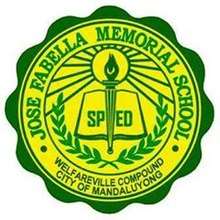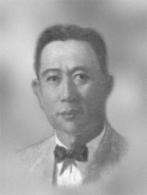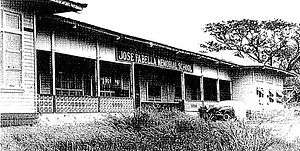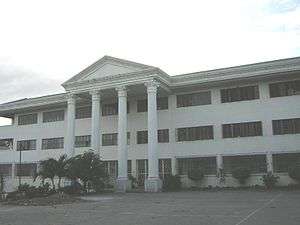Jose Fabella Memorial School
| Jose Fabella Memorial School | |
|---|---|
 | |
| Address | |
|
Welfareville Compound Mandaluyong City, Metro Manila 1550 Philippines | |
| Information | |
| Type | Public |
| Established | 1925 |
| Founder | Jose F. Fabella |
| Oversight | Department of Education |
| Principal | Olivia L. Pagurayan |
| Faculty | 75 (2015) |
| Grades | K to 12 |
| Enrollment | 2,622 (2014) |
| Language | English, Filipino |
| Campus | Urban |
| Color(s) | Green and yellow |
| Nickname | Fabellans |
| Newspaper |
The Fabellan Journal (English) Ang Tanglaw (Filipino) |
| Song | The JFMS March |
| Website |
jfmsmandaluyong |

The Jose Fabella Memorial School (Filipino: Pang-alaalang Paaralang Jose Fabella; abbreviated as JFMS and commonly known as Fabella) is a public integrated special school located in Welfareville Compound, Mandaluyong City in Metro Manila, Philippines.[1] Established in 1925 as the Welfareville School, it is considered as one of the oldest educational institutions in Mandaluyong City[2] and is currently one of the four public special schools in the Philippines.[3][4] It serves as the umbrella organization of 12 special education units located in different parts of Metro Manila and Rizal[5] and offers kindergarten, elementary, secondary (junior and senior high school) and special education to regular students and students with additional needs.[1]
History
The history of JFMS traces its roots to Act No. 267 enacted by the Philippine Legislature on January 10, 1917 which established the first government orphanage and marked the beginning of the national child welfare program in the Philippines.[6] On December 3, 1924, Act No. 3203 was passed placing "public institutions intended for the care, custody, correction, education and training of orphans, homeless, neglected, abused, defective and delinquent children under the administration and supervision of the Bureau of Public Welfare".[7] In 1925, the Commission of Public Welfare, replacing Bureau of Public Welfare, purchased a 56-hectare land in the municipality of Mandaluyong, Province of Rizal, where the government's child-caring institutions were established and collectively called Welfareville School.[6] It originally consisted of 1) the Philippine Training School for Boys and the Philippine Training School for Girls, which provided for the education of delinquent boys and girls; 2) orphanage, to provide for the care and education of destitute children and children of leprous parents; 3) nursery for non-leprous children below two years of age, to provide care and education of children of leprous parents born in Culion;[8][9] 4) home for the mentally-defective children, to provide care and treatment of boys and girls who are mentally defective; and 5) home for the aged and the infirm, to provide institutional care for such person who are destitute.[7] Due to the increasing number of children and other beneficiaries admitted to Welfareville School, a sum of ₱500,000 was appropriated by the end of 1938 for the construction of additional buildings for the care of orphans, destitute, underprivileged, handicapped and crippled children and for the home of the aged and the infirm.[7]
For many years since its establishment, there have been calls to change the name of the school to remove the stigma associated with it as the "dumping ground of society's rejects."[10][11] On June 21, 1963, Republic Act No. 3576 was passed changing the name of Welfareville School to Jose Fabella Memorial School.[12][13] This is in honor of Dr. Jose F. Fabella, the first Commissioner of the Bureau of Public Welfare[7] and considered as the Father of Public Health and Social Welfare in the Philippines,[14][15] who laid the plan for the development of Welfareville School.[16] The said law also placed the supervision of JFMS from the Social Welfare Commission, now the Department of Social Welfare and Development to the Special Subjects and Services Division of the Bureau of Public Schools and later to the Special Education Unit of the Department of Education.[11]
Following an agreement between the Philippine government and the United Nations Children's Fund to upgrade the child welfare services in the Philippines, Republic Act No. 5260 was enacted on June 15, 1968 which called for the dispersion and decentralization of the institutions in Welfareville Compound.[17] This resulted to the dispersal of the special education units of JFMS in Metro Manila and outskirts. On August 11, 2011, Republic Act No. 9155 was passed which placed JFMS under the Schools Division Office of Mandaluyong City.[18][11][19]
At present, JFMS is one of the four public special schools in the Philippines[3][4] and consists of a main campus in Mandaluyong City which caters to regular students and students with learning disabilities and behavioral problems and 12 units located in different parts of Metro Manila and Rizal which cater to students with additional needs.[5][11]
JFMS Units
| Unit | Location | Purpose |
|---|---|---|
| Nayon ng Kabataan[20] | Welfareville Compound, Mandaluyong City | provides care and shelter for abused, orphaned, abandoned, neglected and exploited children aged 7 to 17 years old. |
| Bagong Sinag Special School | National Center for Mental Health, Mandaluyong City | provides care and shelter for mentally-handicapped patients. |
| Jose Fabella Center | Correctional Road, Mandaluyong City | provides temporary shelter for strandees, transients, vagrants and mendicants. |
| Dangerous Drugs Board—European Union Treatment and Rehabilitation Center | Diliman, Quezon City | provides shelter and rehabilitation for people with drug dependence. |
| CRIBS Foundation, Inc.[21] | Industrial Valley, Marikina City | provides care for the abandoned, neglected, surrendered and female minor survivors of child abuse. |
| Special Learning Center | City Hall, Quezon City | provides care for children with behavioral problems. |
| Department of Health Treatment and Rehabilitation Center | Bicutan, Taguig City | provides treatment for children and adults with drug addiction. |
| Elsie Gaches Village | Alabang, Muntinlupa City | provides care and rehabilitation for abandoned and neglected children with mild to severe mental disorders. |
| National Training School for Girls | Alabang, Muntinlupa City | provides care and shelter for abandoned female street children. |
| National Training School for Boys[22][23] | Tanay, Rizal | provides care and rehabilitation to male juveniles in conflict with the law aged 9 to 17 years old. |
| Haven for Children | Alabang, Muntinlupa City | provides rehabilitation facilities for boys aged 7 to 13 recovering from substance abuse. |
| Molave Youth Homes | City Hall, Quezon City | provides care for children with behavioral problems. |
Administration
As a public school, JFMS is an educational institution of the Department of Education. It is directly supervised by the Schools Division Office of Mandaluyong City which oversees all public and private elementary and secondary educational institutions, including alternative learning systems in its jurisdiction.[24][11] JFMS is headed by a Special Schools Principal with the assistance of two Assistant Principals, for Elementary and Secondary, all of whom are designated by the Schools Division Office. The special education units of JFMS are headed by Teachers-in-Charge designated by the principal.[25]
JFMS is broadly organized into two departments: Elementary and Secondary, each headed by a department head; 12 grade levels: Grades 1 to 12, each headed by a grade level chairperson; and eight subject areas for elementary and secondary, each headed by a subject area coordinator. [25]
As of 2015, JFMS had a total of 104 personnel complement, including 39 elementary and 36 secondary special education teachers.[1]
Campus
The main campus of JFMS sits on a portion of 56-hectare government land which is now the sprawling Welfareville Compound.[11] Other government agencies located in the vicinity of JFMS include the Nayon ng Kabataan (front), Welfareville Commission (left) and Commission on Population (right). The units of JFMS are located in Metro Manila, except for the National Training School for Boys which is situated in Tanay, Rizal.[11]
People
People affiliated with the school as students, graduates, and teaching and non-teaching personnel are called "Fabellans." Graduates of the school are inducted annually as members of the Jose Fabella Memorial School Alumni Association. Olivia L. Pagurayan, a former professor of special education at Philippine Normal University, serves as its current principal.
Gallery
 Bust of Dr. Jose Fabella
Bust of Dr. Jose Fabella Dormitory of Philippine Training School for Boys, ca. 1950s
Dormitory of Philippine Training School for Boys, ca. 1950s Old administration building of Welfareville School, ca. 1950s
Old administration building of Welfareville School, ca. 1950s Dormitory of Philippine Training School for Girls, ca. 1950s
Dormitory of Philippine Training School for Girls, ca. 1950s Mess Hall, ca. 1950s
Mess Hall, ca. 1950s Gabaldon Building, ca. 1960s
Gabaldon Building, ca. 1960s Present Administration Building, ca. 2000s
Present Administration Building, ca. 2000s New High School building
New High School building
References
- 1 2 3 "Jose Fabella Mamorial School". Jose Fabella Mamorial School. Retrieved 2016-12-29.
- ↑ https://jfmsmandaluyong.wordpress.com/
- 1 2 "Senate takes up Special Education bills | Sen. Pia S. Cayetano". senatorpiacayetano.com. Retrieved 2017-01-10.
- 1 2 "Government Special Schools". National Council on Disability Affairs. Retrieved 2017-01-10.
- 1 2 "FACULTY". Jose Fabella Mamorial School. 2012-05-16. Retrieved 2016-12-29.
- 1 2 Pangan, Angela Maria (1999-01-01). "Looking into the Philippine foster care experience: Trends and challenges". Children Australia. 24 (4): 76–88. doi:10.1017/S1035077200009421. ISSN 1035-0772.
- 1 2 3 4 Murillo, Agapita (1944-01-01). "Public Welfare Services in the Philippines, 1898-1941". Social Service Review. 18 (2): 189–204. JSTOR 30014210.
- ↑ ARCILLA, JOSÉ S. (2009-01-01). "The Culion Leper Colony, 1900s-1970s". Philippine Studies. 57 (2): 307–326. JSTOR 42634012.
- ↑ Anderson, Warwick (2006-07-31). Colonial Pathologies: American Tropical Medicine, Race, and Hygiene in the Philippines. Duke University Press. ISBN 0822388081.
- ↑ "Ferdinand E. Marcos, Fourth State of the Nation Address, January 27, 1969 | GOVPH". Official Gazette of the Republic of the Philippines. Retrieved 2016-12-29.
- 1 2 3 4 5 6 7 "HISTORY". Jose Fabella Mamorial School. 2012-05-16. Retrieved 2016-12-29.
- ↑ "National Library of the Philippines Online Public Access Catalog Catalog -- ISBD". koha.nlp.gov.ph. Retrieved 2016-12-29.
- ↑ panonad. "Republic Act No. 3576 : REPUBLIC ACTS - PHILIPPINE LAWS STATUTES and CODES - CHANROBLES VIRTUAL LAW LIBRARY". laws.chanrobles.com. Retrieved 2016-12-29.
- ↑ F, Fabella Jose; Ricafrente, Gerardo S. (2008-01-01). White hero: Dr. Jose F. Fabella, 1888-1945, father of public fealth and social welfare. Richforehead Publications. ISBN 9789719236443.
- ↑ Ricafrente, Gerardo S. White hero : Dr. Jose F. Fabella, 1888-1945, father of public fealth and social welfare / [author, Gerardo S. Ricafrente, Jr.]. [Mandaluyong City]: Richforehead. ISBN 9789719236443.
- ↑ "Dr. Jose Fabella | Department of Health website". www.doh.gov.ph. Retrieved 2016-12-29.
- ↑ Firm, Ronald Echalas Diaz, Chan Robles & Associates Law. "PHILIPPINE LAWS, STATUTES AND CODES - CHAN ROBLES VIRTUAL LAW LIBRARY". www.chanrobles.com. Retrieved 2016-12-29.
- ↑ https://depedmandaluyong.org/schools/integrated/
- ↑ "Republic Act No. 9155 | GOVPH". Official Gazette of the Republic of the Philippines. Retrieved 2016-12-29.
- ↑ https://ncr.dswd.gov.ph/2014/04/recognition-day-in-nayon-ng-kabataan/
- ↑ http://newsinfo.inquirer.net/662107/havens-40-year-work-of-god-lauded-in-marikina
- ↑ https://fo4a.dswd.gov.ph/2016/03/13-ntsb-residents-graduate-from-elementary/
- ↑ https://fo4a.dswd.gov.ph/2016/03/16-ntsb-residents-complete-junior-high-school/
- ↑ https://depedmandaluyong.org/about/vmcvm/
- 1 2 https://jfmsmandaluyong.wordpress.com/organization/
Coordinates: 14°35′06″N 121°02′04″E / 14.58500°N 121.03444°E